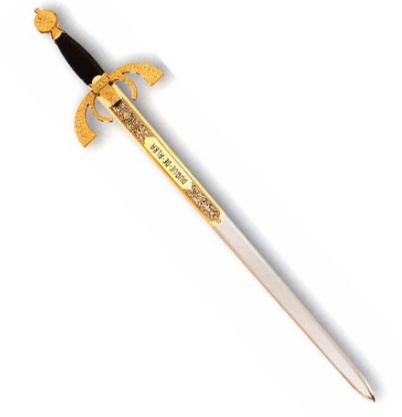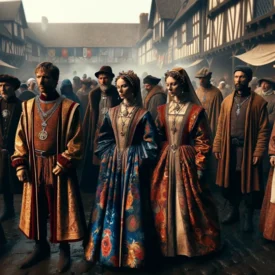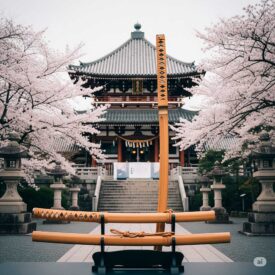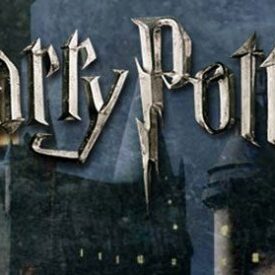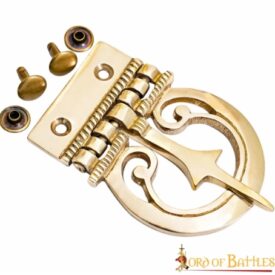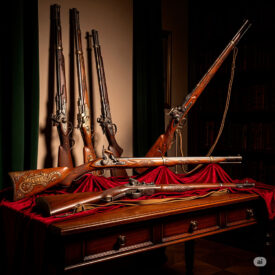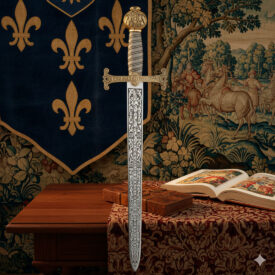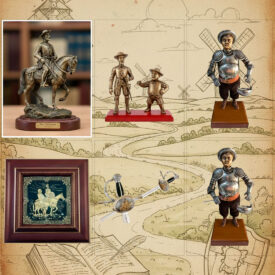Fernando Álvarez de Toledo y Pimentel, universally known as the Grand Duke of Alba, is one of the most relevant military and political figures of the 16th century in Spain. His victories, his reputation, and the honors he received have fueled both admiration and historical controversy. In this article, we delve into the swords of the Grand Duke of Alba, the exceptional recognitions granted to him, the iconography that accompanied him, and how today faithful replicas can be found or acquired in our online store.
Who was the Grand Duke of Alba: a brief and forceful life
Born in Piedrahita (Ávila) on October 29, 1507, Fernando Álvarez de Toledo had an early and brilliant military career. At the age of six, he accompanied his grandfather to Navarre, and at seventeen, he joined the troops of Constable Iñigo de Velasco. He served Charles I and Philip II with loyalty and efficiency that led him to hold positions of maximum responsibility, including Captain General and Viceroy of Portugal.
His military career includes campaigns in Italy, the defense of Vienna, in the Mediterranean against the corsair Barbarossa, and the conquest of Portugal. These campaigns forged the Duke’s fame and also the iconography of his weapon: the sword, a symbol of his authority and his position as the executor of royal power.
He died in Lisbon on December 11, 1582, and his remains rest in the monastery of El Escorial. Throughout his life, he accumulated both papal honors and political criticisms, which were often embodied in forceful images such as that of the “executioner’s sword.”
The Duke’s weapons: styles and functions of his swords
When we talk about the swords of the Grand Duke of Alba, we must differentiate between the practical combat weapon, ceremonial symbols, and artistic representations. The swords of a 16th-century general could vary according to their use:
- Campaign sword: robust, balanced, designed for combat and personal protection.
- Ceremonial sword: richly decorated, with elaborate scabbards and hilts, intended for public acts and to display rank.
- Honorary rapiers: symbolic weapons that accompanied papal concessions or royal distinctions.
The preserved images and modern replicas allow us to appreciate details of the hilt, guard styles, and decoration, elements that today attract collectors, museums, and military history enthusiasts.
Papal Honors: the Golden Rose and the Blessed Rapier
Among the recognitions that reinforced the Duke’s image as a defender of Christendom, the Golden Rose and an extraordinary gesture from the papacy stand out: the bestowal of a blessed rapier by Saint Pius V.
On December 26, 1566, Saint Pius V granted the Duke of Alba, in addition to the Golden Rose and a biretta, a blessed rapier. This honor was exceptional and reserved for monarchs, princes, and military leaders who had rendered extraordinary services to Christendom. This concession was only recorded on two occasions in the 16th century: to the Duke of Alba himself and, later, to Don Juan de Austria, after the victory of Lepanto in 1571.
The delivery ceremony took place in 1568 in the cathedral of Saint Gudula in Brussels, where he was also given a hat with the dove of the Holy Spirit embroidered and presented with the bucaro containing the golden rose. The iconography of this event was captured in a preparatory sketch by Jean-Auguste-Dominique Ingres, which is preserved in the Montauban museum; the work depicts the reception of the rapier and the blessed hat by His Holiness.
From a symbolic point of view, receiving a blessed rapier meant being recognized as a champion of the faith, someone whose military authority was accompanied by public spiritual backing from the papacy. For the Duke of Alba, this distinction further reinforced his figure as a defender of Catholicism in a Europe convulsed by religious wars.
What did the blessed rapier represent?
The blessed rapier was less a practical weapon than an emblem. In symbolic terms, it meant:
- Public recognition from the papacy for extraordinary services in defense of Christendom.
- A moral and religious sanction that accompanied military authority.
- An element of prestige that reinforced the political power of the recipient.
Although there were rapiers and swords of liturgical and ceremonial value, their concession to a military man was exceptional; in fact, available information indicates that this type of distinction continued to be granted sparingly until the 19th century, with General Kauzler being the last to receive one in 1877.
The metaphor of the “executioner’s sword”: criticism and the Black Legend
The figure of the Duke of Alba was also marked by controversy. Critical authors, such as Pompeyo Gener, used powerful images to denounce his harshness: Gener describes Alba as someone who wielded an “executioner’s sword” in one hand and the flame of the Holy Office in the other, accusing him of “homicidal fury.”
It is essential to understand that this expression is a literary metaphor. There is no evidence that the Duke possessed a literal “executioner’s sword.” Gener’s phrase is part of a broader discourse known as the Black Legend, a propaganda construct that sought to emphasize the supposed cruelties of 16th-century Spanish power.
Analyzing these criticisms in their context allows us to differentiate between political denunciation and verifiable facts: the Duke was responsible for military campaigns and repressive measures, especially in the Netherlands, but the imagery of the “executioner’s sword” belongs to the rhetorical and symbolic realm.
Battles, victories, and key moments related to his sword
Throughout his career, the Duke participated in decisive confrontations that marked Spanish hegemony. Among the most significant moments linked to his figure and the warlike image he established are:
- Defense of Vienna (1532), when the imperial show of force deterred the Ottoman assault.
- Campaigns in the Mediterranean and the capture of Tunis (1535), confronting Barbarossa.
- Interventions in Flanders, where his actions earned him international notoriety—and controversy—for his firmness against the rebellion.
- The Portuguese campaign (1580), in which he was appointed Constable and Viceroy after the victory at Alcántara.
In all these scenarios, the commander’s sword appears as a symbol of command. The chronicles of the time and official portraits show the Duke with weapons that blend functionality and ostentation, depending on the occasion.
A general of many facets
Beyond the warrior, the Duke was an administrator, diplomat, and courtier. His military legacy coexisted with the careful construction of a public image: the sword was both an instrument and an attribute for political iconography.
Historical swords and replicas: how the material is recovered
Historical research and restoration work today allow us to better understand the weapons of the period. Studies combine painting analysis, archival documentation, and the examination of pieces preserved in collections to recreate historical swords with authenticity criteria.
For collectors and enthusiasts, there are faithful replicas that reproduce the design, materials, and techniques, but also versions intended for exhibition that prioritize aesthetics. If you are looking for a replica of the Grand Duke of Alba’s sword, in our online store we have models that combine historical accuracy with suitable materials for display.
Keys to choosing a historical replica
- Type of use: exhibition, recreation, or collecting.
- Materials: steel, brass or silver details, leather or wood-lined scabbard.
- Fidelity: reproduction of the hilt, pommel, and decoration according to historical models.
- Finish: aged or polished, according to preference.
Our online store offers advice on models, measurements, and maintenance to keep the piece in perfect condition.
Cultural Legacy: Art, Literature, and Memory
The figure of the Duke of Alba has inspired paintings, biographies, and historical debates. His weapons are recurring elements in period portraits and in artistic compositions that seek to convey authority and drama.
Ingres’s sketch depicting the bestowal of the blessed rapier is an example of how religious symbolism and the representation of power intertwine around objects such as the sword. In turn, critical rhetoric—such as the metaphor of the “executioner’s sword”—shows the extent to which weapons also serve as a narrative tool in political and moral conflicts.
Where to see and buy replicas of the Grand Duke of Alba’s swords
If you want to contemplate historical pieces, you can visit museums that house 16th-century collections or temporary exhibitions about the period. To acquire a faithful and guaranteed replica, we recommend visiting our online store, where you will find a selection of swords of the Grand Duke of Alba and other historical Spanish swords with detailed descriptions, measurements, and photographs.
Buying in our online store ensures technical advice, secure shipping options, and certificates of authenticity for pieces that require them. We also offer conservation recommendations and accessories such as historically appropriate stands and scabbards.
If you need help choosing, our online store will guide you on which model best suits your interest, whether historical, decorative, or for reenactment.
SEE MORE SWORDS OF THE GRAND DUKE OF ALBA | SEE OTHER HISTORICAL SPANISH SWORDS
The life of Fernando Álvarez de Toledo and the symbolism of his sword remain fascinating chapters in the military and cultural history of Spain. Amid papal honors, campaigns, and controversies, the image of his weapon—whether real, ceremonial, or metaphorical—continues to evoke the complexity of a time when war, religion, and power were inseparably intertwined.

